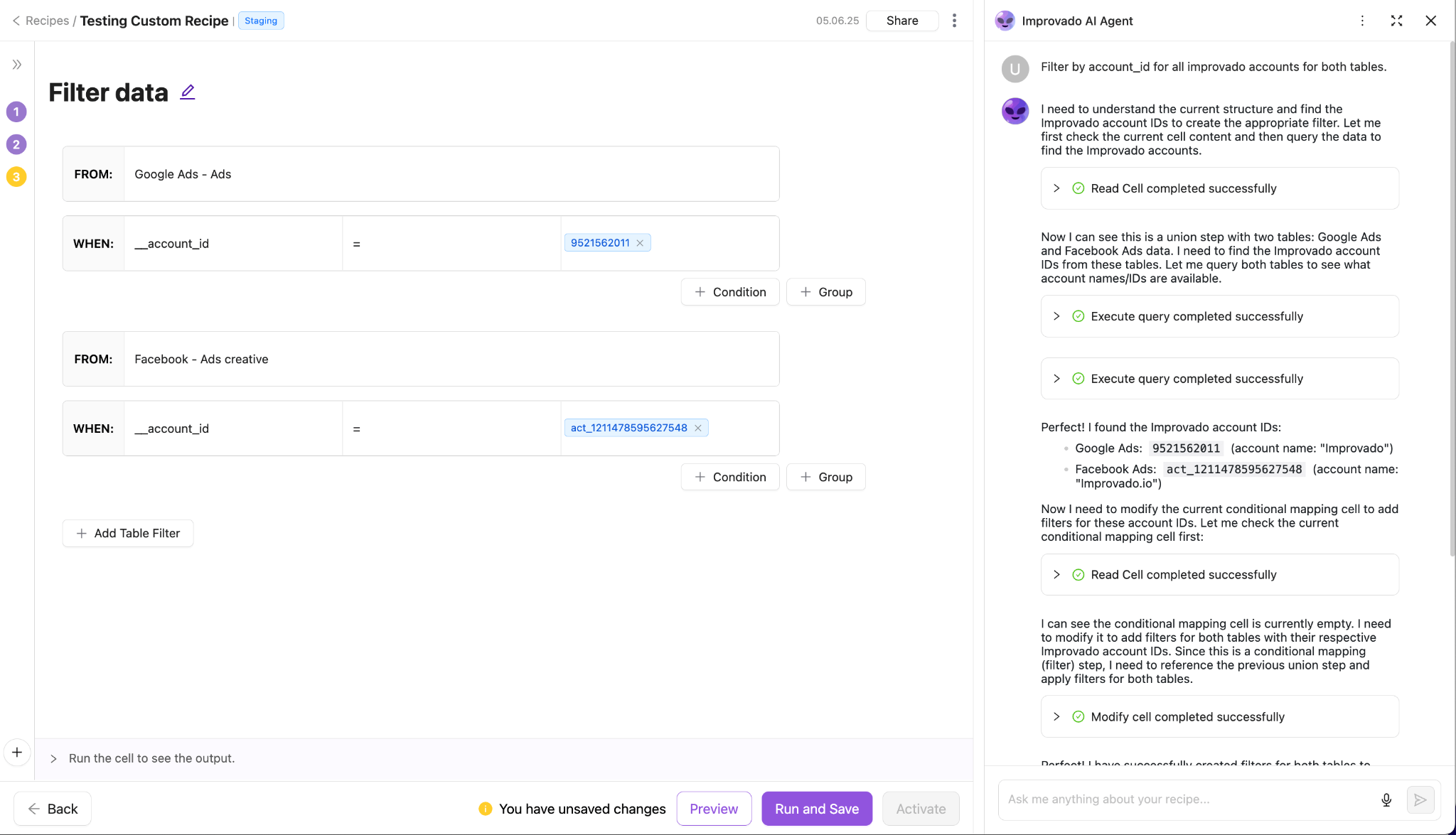Enterprise marketing teams deal with a constant influx of raw data — streaming from ad platforms, web analytics, offline sources, and internal systems — each with unique structures and naming conventions. As this volume grows, so does the risk of duplication, misaligned metrics, and reporting delays. What should be a foundation for insight often becomes a source of confusion, slowing decision-making and obscuring true performance signals.
This guide examines the role of data transformation in solving these challenges. It breaks down the frameworks, workflows, and tools needed to standardize, enrich, and connect disparate datasets, creating a reliable layer of information that drives accurate analytics, consistent reporting, and smarter marketing decisions.
Key Takeaways:
- Data transformation is foundational to creating accurate, analytics-ready datasets by harmonizing fragmented marketing data across platforms, regions, and teams.
- Cloud-based ELT workflows offer flexibility and scalability, enabling near real-time processing and efficient storage of both raw and transformed datasets.
- AI-powered transformation accelerates workflows by automating data cleaning, mapping, enrichment, and anomaly detection, reducing dependency on engineering teams.
- Governance and standardization, including common data models and lineage tracking, are essential to ensure compliance, consistency, and long-term scalability.
- Platforms like Improvado centralize and automate complex transformation processes, turning raw marketing data into a single source of truth for reporting and advanced analytics.
What Is Data Transformation?
Data transformation touches every stage of the data lifecycle: cleaning errors, standardizing formats, normalizing scales, enriching with supplemental information, and aggregating for high-level insights.
For marketing analytics teams, this means aligning data across channels, resolving inconsistent metric definitions, and enriching campaign data to clearly attribute revenue impact, tasks that platforms like Improvado can automate and streamline.
Data Transformation Process
Data rarely arrives in a clean, consistent format. It flows in from ad platforms, CRMs, analytics tools, and offline systems, each using different structures, naming conventions, and taxonomies.
A structured approach turns fragmented datasets into a unified, analytics-ready asset that can be trusted for decision-making at scale.
A comprehensive data transformation process typically follows these key phases:
- Data discovery: Conducting an in-depth profile of raw datasets to uncover structures, anomalies, and quality issues. This step highlights discrepancies like missing values, duplicate records, or inconsistent campaign identifiers before they propagate downstream.
- Data mapping: Establishing clear relationships between fields across systems and defining normalization rules, such as date formats, currencies, geographic codes, or campaign naming standards, to align data for cross-platform reporting.
- Transformation logic development: Creating and documenting transformation rules. This may involve SQL or Python scripts for custom pipelines or low-code/no-code recipes for repeatable processes, ensuring complex business logic is consistently applied.
- Execution: Running transformations at scale through ETL/ELT pipelines or automated workflows. This stage must handle large, multi-source datasets reliably while supporting both batch and real-time updates.
- Review and validation: Verifying the transformed data against quality benchmarks and business requirements. This includes reconciliation checks, metric validation, and stakeholder sign-off to confirm accuracy before data is surfaced for reporting or modeling.
Types of Data Transformation
Data transformation isn't a one-size-fits-all process. In fact, it's a multifaceted set of techniques tailored to specific use cases, data types, and organizational goals.
Whether you're preparing marketing campaign data for analysis, shaping features for predictive modeling, or anonymizing customer information, understanding the types of transformation is essential.
Here are the primary categories of data transformation:
- Aesthetic Transformation: Standardizes surface-level elements like naming conventions, date formats, currencies, and geographic codes. This step creates a uniform “look and feel” that enables basic alignment across systems without altering the underlying data meaning.
- Constructive Transformation: Generates new, meaningful data points by combining, calculating, or merging existing fields. Examples include deriving Return on Ad Spend (ROAS) from spend and revenue, or blending campaign-level data across channels into a unified performance metric.
- Destructive Transformation: Removes unwanted, irrelevant, or erroneous data. This includes purging duplicate records, eliminating incomplete transactions, or filtering out invalid campaign identifiers to ensure data integrity and reduce noise in downstream analysis.
- Structural Transformation: Reshapes datasets to fit analytical workflows or BI tools. This could involve pivoting campaign-level logs into summary tables, splitting complex fields into separate attributes, or unifying multi-channel hierarchies for cross-platform reporting.
- Encoding and Normalization: Converts categorical or disparate values into comparable structures, often required for machine learning models or statistical analysis. This includes encoding campaign names as numeric codes or normalizing spend across multiple currencies and markets to standardize KPIs.
- Enrichment and Imputation: Enhances datasets by adding external metadata or filling gaps in incomplete records. For marketing use cases, this could mean appending demographic data to customer profiles or using algorithmic methods to estimate missing conversion values.
Enterprise Data Transformation
At the enterprise level, data transformation is not just about cleaning or reformatting data. It’s a strategic function that drives alignment, scalability, and innovation across the entire organization.
With data flowing in from hundreds of marketing, sales, finance, and product systems, the objective shifts from isolated reporting to building a unified, governed data layer. This foundation enables teams to collaborate effectively, scale operations globally, and make decisions based on consistent, trusted information.
Key Challenges of Enterprise-Scale Transformation
Enterprise data environments come with unique complexities that make transformation mission-critical:
- Massive data volume and velocity: Handling billions of rows of data from multiple regions and channels in real time.
- Consistency across departments and regional offices: Maintaining standardized metrics and taxonomies across brands, geographies, and business units.
- Integrating diverse sources: Combining first-party, third-party, offline, and in-house datasets into a single analytics-ready structure.
- Strict governance and compliance: Enforcing auditability, data lineage tracking, and security controls to meet global privacy and compliance standards.
Without a structured, scalable approach, these challenges create silos, reporting discrepancies, and operational inefficiencies that undermine performance.
How Improvado Supports Enterprise-Ready Transformation

Improvado provides a platform purpose-built to address these enterprise challenges, combining automation, AI-driven intelligence, and governance into a single solution.
- Transform & Model Capabilities: Improvado centralizes data from over 500 sources and applies consistent taxonomies, rules, and business logic at scale. Teams can create reusable, modular transformation workflows that ensure uniform data structures across brands, regions, and campaigns — without heavy reliance on engineering teams.
- AI-Powered Transformation Agents: With Improvado’s AI Agent for Transformation, repetitive tasks like mapping, normalization, and enrichment are automated. The AI suggests transformations, detects anomalies, and flags discrepancies, reducing manual workload and accelerating time-to-value.
- Built-In Governance and Security: The platform includes strict version control, audit trails, and data lineage tracking. These features give enterprise teams confidence that transformed datasets are accurate, compliant, and secure — critical for scaling operations across multiple markets and regulatory environments.
By combining these capabilities, Improvado enables enterprise marketing organizations to move from fragmented, error-prone pipelines to a fully governed, analytics-ready environment, all while reducing manual effort and operational risk.
AI Data Transformation
Artificial intelligence is fundamentally reshaping how organizations approach data transformation, replacing manual, error-prone workflows with intelligent, automated processes.
By leveraging machine learning, natural language processing (NLP), and generative AI, businesses can streamline complex tasks like cleaning, mapping, and feature engineering — while maintaining high standards of data quality and reducing dependency on engineering resources.
Core Benefits of AI-Powered Transformation
- Automated Cleaning and Preprocessing: AI models continuously scan datasets for inconsistencies, missing values, and outliers, applying corrective actions without human intervention. This dramatically reduces manual data preparation effort while improving reliability and auditability.
- Intelligent Integration and Feature Engineering: AI can merge disparate datasets and infer relationships between fields, even when schemas or taxonomies differ. It can also propose or automatically create new calculated metrics such as predictive KPIs or advanced attribution fields to enrich downstream analytics.
- Accelerated Logic Generation and Documentation: Generative AI tools, like dbt Copilot, assist in writing transformation code, test cases, and documentation at scale. This reduces development time while ensuring accuracy and maintainability across global teams.
- Natural Language Self-Service: Marketing professionals can now request transformations and insights in everyday language, for example, “generate ROAS by campaign and region,” and receive structured, analytics-ready data in seconds.
Why It Matters for Marketing Analytics Teams
In marketing, where data comes from hundreds of channels and platforms, AI-driven transformation brings four critical advantages:
- Faster time to insight through automated pipeline generation and intelligent data preparation.
- Higher data consistency and trust with continuous anomaly detection and validation.
- Broader accessibility, empowering marketers and analysts without SQL or coding expertise to shape and explore datasets independently.
- Scalability and adaptability, ensuring transformation processes evolve seamlessly as data volume and complexity grow.
By integrating AI into their transformation workflows, marketing analytics teams can focus less on managing pipelines and more on strategic initiatives from forecasting campaign performance to optimizing customer journeys and driving revenue growth.
Cloud Data Transformation
Unlike legacy on-premise systems, cloud-based architectures allow teams to centralize data from hundreds of sources, run complex transformations at scale, and deliver analytics-ready outputs in near real time, all without the constraints of fixed hardware or rigid pipelines.
In this environment, ELT (Extract, Load, Transform) has emerged as the dominant workflow pattern. Raw data is ingested directly into a cloud data warehouse, where transformations are executed at query time or as scheduled processes.
This reduces the need for heavy pre-processing and enables organizations to retain both raw and transformed datasets side-by-side, supporting historic analysis and advanced modeling.
Key advantages of cloud-driven transformation include:
- Elastic scalability: Seamlessly process billions of rows as marketing data volumes spike during seasonal campaigns or product launches.
- Flexible, on-demand transformations: Apply business logic dynamically, without being locked into rigid pre-transformation pipelines.
- Real-time sync and refresh cycles: Keep reporting layers continuously updated with the latest performance metrics.
- Cost efficiency: Pay only for compute and storage used, optimizing infrastructure spend as needs evolve.
Data Transformation Solutions
Data transformation solutions vary widely in design and complexity, reflecting the unique needs of different organizations, data environments, and levels of analytics maturity. For marketing analytics teams, the right approach depends on factors like data volume, source diversity, latency requirements, and governance needs. Below is an overview of the most common solution types and how they fit into modern marketing data workflows:
1. Traditional ETL Pipelines
These solutions follow the classic Extract, Transform, Load model, where data is cleaned and standardized before being moved into a data warehouse or data mart.
- Best for: Highly structured data and predictable batch workflows.
- Advantages: Strong data quality enforcement, well-defined validation processes, and reliable governance.
- Use cases: Nightly or weekly campaign data updates, compliance-driven industries with strict data handling rules.
- Limitations: Slower iteration cycles, less suited for fast-changing marketing datasets.
2. Modern ELT Pipelines
The Extract, Load, Transform approach reverses the sequence, first loading raw data into a cloud warehouse and then transforming it directly within the platform using SQL or compute-intensive queries.
- Best for: Cloud-first environments leveraging scalable infrastructure like Snowflake or BigQuery.
- Advantages: Faster iteration, dynamic transformation workflows, and better use of cloud-native compute power.
- Use cases: Large-scale, multi-source marketing data requiring flexible modeling and rapid experimentation.
- Limitations: Requires well-defined governance to avoid inconsistent transformation logic across teams.
3. Real-Time and Streaming Transformation
Streaming ETL/ELT processes ingest and transform data continuously, delivering near-instant updates for analytics and reporting.
- Best for: Use cases where immediacy is critical, such as campaign pacing or fraud detection.
- Advantages: Supports real-time dashboards, campaign monitoring, and automated anomaly detection.
- Use cases: Retail media networks, programmatic advertising, or live campaign optimization.
- Limitations: Complex to implement and maintain; demands high levels of infrastructure orchestration.
4. Interactive and No-Code Transformation Interfaces
Visual and no-code transformation platforms enable domain experts such as marketing analysts to design and manage transformation workflows without deep technical expertise.
- Best for: Teams seeking agility and reduced reliance on engineering resources.
- Advantages: Democratizes data access, accelerates modeling cycles, and reduces bottlenecks in pipeline management.
- Use cases: Rapid prototyping of marketing attribution models, ad hoc campaign analysis.
- Limitations: Governance and scalability can be challenging without strong version control and process discipline.
5. Data Virtualization Layers
Virtualization provides a unified view of data across multiple systems by applying transformations on the fly, without physically moving the data.
- Best for: Quick insights and exploratory analysis without the overhead of building full pipelines.
- Advantages: Minimal duplication, lower storage costs, and faster deployment timelines.
- Use cases: Cross-channel performance snapshots, lightweight reporting initiatives.
- Limitations: Limited performance for heavy analytics or long-term data governance.
Data Transformation Best Practices
Below are ten best practices for enterprise marketing analytics teams to follow when designing and managing transformation workflows.
1. Start with Data Discovery and Profiling
Before defining any mapping or rules, conduct a deep analysis of your datasets. Profiling helps identify structural inconsistencies, missing values, duplicates, and schema mismatches early. By uncovering these issues up front, teams can design transformations that are robust and resilient to future changes in source data.
2. Leverage Standardized Data Models
Adopt a unified model to align fields, metrics, and naming conventions across channels. A standard model serves as a common language for all stakeholders, simplifying integration and reducing the need for repetitive mapping, especially across multi-channel, multi-brand datasets.
3. Maintain Auditability and Version Control
Every transformation should be traceable. Capture metadata such as timestamps, rule versions, and rationale for changes. Techniques like data lineage tracking provide visibility into the entire process, ensuring compliance, simplifying debugging, and supporting change management as business logic evolves.
4. Validate with Representative Samples
Test transformation logic on sample datasets before executing at full scale. This proof-of-concept stage helps catch logic errors, schema drift, and integration issues while minimizing the risk of breaking production pipelines.
5. Continuously Monitor Data Quality
Deploy automated monitoring to detect anomalies, schema changes, or unexpected fluctuations in data volume. Alerts for missing fields, null spikes, or sudden value shifts allow teams to act before data issues propagate to downstream analytics or AI models, preserving trust in reporting.
6. Balance Automation with Flexibility
Automation accelerates workflows and reduces manual intervention, but marketing data often includes edge cases and custom business rules. Choose platforms that offer pre-built, repeatable workflows alongside the ability to implement bespoke logic for specialized calculations, such as advanced attribution modeling or dynamic budget pacing.
7. Optimize for Cloud ELT Performance
In cloud-native ELT environments, performance optimization is critical. Leverage partitioning, query optimization, and efficient compute resource management to reduce latency and control costs. Poorly optimized pipelines can cause delays in reporting and unnecessary infrastructure expenses.
8. Enable AI-Powered Self-Service Transformation
Empower analysts and marketers to request and preview transformations using natural language or intuitive interfaces. AI-driven tools allow non-technical users to specify desired metrics or aggregations, accelerating iterative analysis and reducing dependency on engineering resources.
9. Document Everything Thoroughly
Maintain comprehensive documentation of transformation logic, field mappings, data recipes, and related resources. Linking this documentation to internal wikis or knowledge bases ensures that teams can quickly understand and maintain transformation processes, supporting faster onboarding and cross-functional collaboration.
10. Align with Governance Early
Engage governance and compliance teams from the outset to align on data privacy, access controls, and regulatory requirements. Early involvement ensures that transformations meet legal and organizational standards, mitigating risks while building trust in the data across the enterprise.
Building a Scalable Future with Data Transformation
As marketing ecosystems expand, transformation becomes a core operational discipline. Without structured, governed processes, inconsistencies in taxonomies, naming conventions, and metric definitions can cascade across reporting layers, leading to misaligned KPIs and unreliable insights.
Improvado was purpose-built to solve these enterprise challenges. The platform automates complex, multi-level transformations with AI-driven workflows and pre-built marketing data models, eliminating manual mapping and repetitive engineering work. With 500+ integrations, granular governance controls, and lineage tracking, Improvado ensures that every dataset, whether from a legacy CRM or a modern ad network, flows into a single, analytics-ready structure.
Future-proof your marketing analytics operations and reduce time-to-insight. Book a demo today to see how Improvado delivers transformation at enterprise scale.
.png)




.png)
